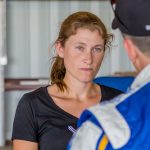
BERLIN – The longtime administrator and curator of the Calvin B. Taylor House Museum stepped down this month after 30 years of service.
Susan Taylor, well known for her devotion to the Taylor House Museum, retired this month after three decades of working as museum administrator and curator.
“We were lucky to have Susan be such a steadfast supporter of the museum,” said Melissa Reid, president of the museum. “She took such a personal interest in Berlin.”
Taylor’s involvement with the museum dates back to the 1980s. A history major, Taylor was fresh out of college when a woman at her church told her the Taylor House Museum needed docents. An initial role guiding visitors through the museum eventually transitioned into a spot on the organization’s board and later positions as administrator and curator. She stepped down this fall to spend more time on her business and with her family at home. Taylor has enjoyed the decades she’s spent helping preserve Berlin’s history.
“It’s important to have a place people can come and see how the town got started,” she said.
Working on the museum’s World War II exhibit was particularly meaningful for Taylor, who recalls how the entire town got involved in the effort.
“We interviewed a lot of our veterans and have their oral histories now,” she said. “We’ve lost a lot of those people and it’s good to have their memories.”
In 2011, Taylor is credited with keeping the museum together following the death of Ed Hammond. Hammond, an attorney, spearheaded the restoration of the Calvin B. Taylor House and created the Berlin Heritage Foundation.
“Ed was a guy who did things close to his chest,” recalled Jan Quick, who at the time headed the museum’s board. “We didn’t know a lot of what was going on.”
Upon the news of his death, however, Taylor was committed to ensuring the museum continued on.
“She and I looked at each other and said we need to hold on to this,” Quick said. “If she hadn’t been there I wouldn’t have known what to do.”
She and other board members are convinced the museum could have fallen into disrepair at that point had Taylor not been at the helm.
“She made the museum last,” Quick said.
In addition to her commitment to the museum, its supporters have come to rely on Taylor’s institutional knowledge.
“You could point to any object in the museum and without looking anything up she could tell you who donated the piece and the history she knew about it,” Reid said.
Board member Patricia Dufendach agreed.
“Her personal knowledge of Berlin has been one of the most important things that keeps the museum together,” she said. Her depth of Berlin history is astounding.”
She’s amazed that Taylor, who started at the museum before computers were being used, was able to get as much done as she did during her time with the museum.
“People would always come in asking her about this and that,” she said. “She was always kind and she put so many people in touch with each other. We’re going to have to work three times harder to make up for what we’re losing.”
While the museum hired Heather Nottingham to assist Taylor as museum administrator a few years ago, filling Taylor’s vacancy as curator will be harder to do. A partnership with Salisbury University’s Institute for Public Affairs and Civic Engagement (PACE) is expected to provide the museum with a curator for at least the next year. Reid is grateful Taylor will be just a phone call away, as questions are sure to come up.
“We don’t even know what we don’t know,” she said. “As soon as we call Susan she’ll be able to fill in the missing pieces.”

